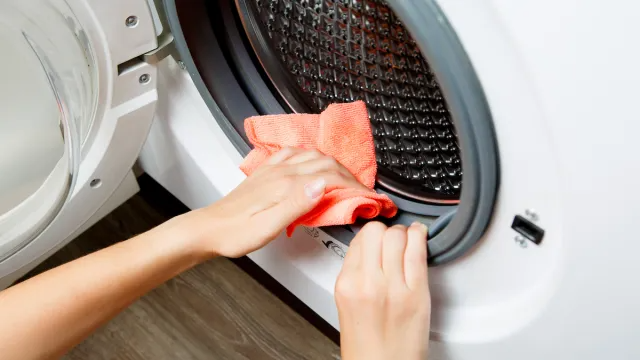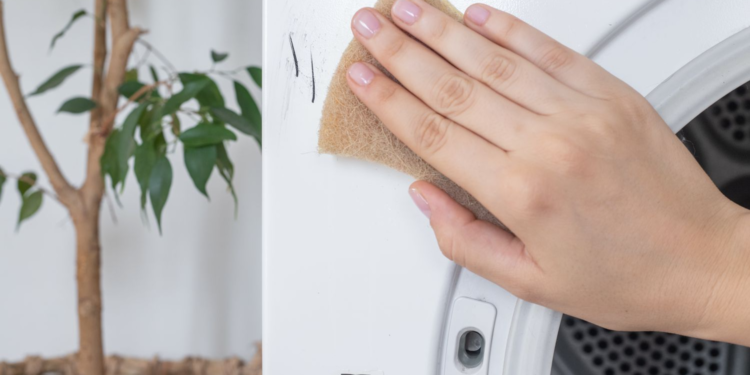Have you noticed some undesirable sediments at the bottom of your washing machine and are curious as to where they came from?
In this blog, we will discuss brown flakes in washing machine and black flakes in washing machine or how to eliminate them.
Several factors frequently cause brown flakes in the washing machine. Accumulating detergent and fabric softener residues over time is a common culprit. Inside the device, this residue can mix with dirt, minerals, and limescale, forming these brown flakes. Furthermore, if the water in your area has a high mineral content, it can exacerbate the problem.
There are brown flakes of laundry that appear dirty on the clothes after machine washing. To check for the presence of brown bits in the washing machine, look for this brown-coloured material covering the surface of the washing tank and other parts.
Many attempts to remove these brown flakes fail due to a lack of knowledge. Washing machines, in general, have such issues with the top loading of the washing machine. The primary cause of brown flakes is improper use and cleaning of the washing machine.
Here are the most common causes of flakes in washing machines
- Dust
- The accumulation of dirt in the machine’s drum
- Mildew
- Abrasive water
- Excessive use of soap or detergent
- Using chlorine bleach in conjunction with hard water
- Fabric softener and laundry detergent residue.
However, when washing with detergents containing specific components, typically chlorine or activated oxygen, a chemical reaction occurs, resulting in iron and manganese particles crystallizing and forming flakes. As a result, these flakes adhere to various parts of the washing machine, creating some fascinating images. Such deposits are commonly referred to as rust.
If you notice brown flakes on your clothes after washing them, there are two potential reasons. When chlorine bleach is used in hard water, it separates iron or manganese and deposits it in the machine.
Iron or manganese can be produced in a front or top-loaded washing machine. However, because of the design of the front load washing machine, they are easily washed before becoming stuck to parts of the washing machine.
In vertical-loading washing machines, particularly those with horizontally rotating tanks. Flakes accumulate where there is no strong current of water, which is beneath the weight of the washing machine’s tank, rod, and bottom.
As it grows, they tear and begin washing clothes.
How Do You Get Rid of Brown Flakes in the Washing Machine?
When washing, don’t use too much laundry detergent. Every week, run an empty load of hot water and washing machine cleaner along with baking soda or vinegar to extend the life of your washing machine.

Laundry should be done with something other than hard water. It is extremely harmful to machines.
- Pour a little vinegar into each load of laundry.
- For laundry, use wool balls.
- Keep dust away from the washing machine.
- Unless necessary, avoid using fabric softener.
A filtration system or a water softener can help prevent brown flakes from forming in your water. This reduces or removes manganese and iron from your water and is recommended for well-watered homes.
Your water should be iron and manganese-free after you install the filter. This will significantly reduce or even prevent the formation of brown flakes inside your washing machine.
Complete the self-cleaning cycle, but it is ineffective; it is washing at the highest temperature and without clothing, and such cleaning removes some deposits.
However, this is due to the ineffective design of the washing machine with top loading. It is impossible to remove iron particles mechanically; they must be dissolved.
Pour some white vinegar and soda into the washing machine and wash- acetic acid soda alkali are also ineffective. You will need to run several cycles to clean the machine completely.
Begin by filling the machine with hot water and the highest load setting. Add two cups of lemon or lime juice if you have an odour problem. Allow the washing machine to complete a complete wash and rinse cycle. If all stains have been removed, run an empty cycle without adding anything to the water.
Remove bleach and fabric softener dispensers and place them in hot water. Remove them from the water and place them on a paper towel after soaking them long enough to loosen most of the build-up.
Spray them with a spray cleaner and use a paper towel to remove dirt. Use the best tips to get dirt out of corners and tight spaces.
Return the dispensers to their original positions in the machine after drying.
Suppose you continue to experience brown flakes even after cleaning the machine. In that case, consider using a water filter or water softener to help minimize mineral deposits in your water supply.
Seeing small sediment at the bottom of your washing machine may be normal. When left to build up, it can cause malfunctioning of the washer or get damaged. Always ensure you use clean water free of sediments to do your laundry. And have a routine cleaning regime for your washer.




